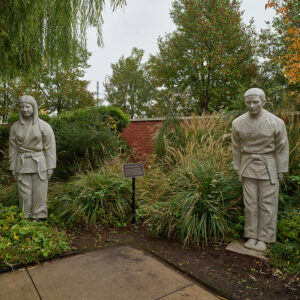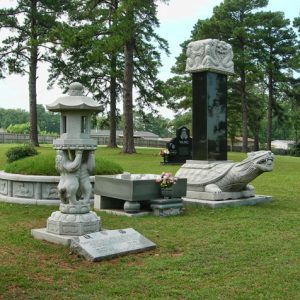calsfoundation@cals.org
Haeng Ung Lee (1936–2000)
Haeng Ung Lee was the founder of the American Taekwondo Association (which later became ATA Martial Arts), headquartered in Little Rock (Pulaski County). ATA has over 300,000 members worldwide, making it the largest organization in North America dedicated to the discipline of taekwondo.
Haeng Ung Lee was born on July 20, 1936, in Manchuria in northeastern China. Little is known about his early life, but shortly after World War II, he and his family moved to Korea. He began training in the martial arts in 1953. Lee progressed rapidly, earning his first-degree black belt only a year later. Upon graduating from high school in 1956, Lee joined the Republic of Korea Army, serving as a martial arts instructor for military intelligence personnel. After his three-year term in the army ended in 1959, Lee founded a private taekwondo school in Osan, South Korea. This school expanded to include several branches, including one located at the U.S. Air Force base in Osan. One of Lee’s soldier-students at the base, Richard Reed, quickly became one of Lee’s closest friends.
Lee’s friendship with Reed ultimately resulted in Lee’s immigration to the United States in 1962. When Reed’s term of service in the air force ended, Lee accompanied him to the United States, where they soon founded a martial arts school in Omaha, Nebraska. Evidently troubled by what he saw as an uneven quality of taekwondo instruction across the United States, Lee began working toward the establishment of a national organization that would ensure consistent standards in both belt advancement and instruction.
In 1969, Lee founded the American Taekwondo Association. In 1973, the same year he gained American citizenship, Lee published an instructor’s manual to ensure quality of instruction among member schools. Prospective instructors were required to complete a rigorous course that included both physical and written exams before earning their certifications. In addition to standardizing instruction, the ATA also offered marketing guidance for its member institutions in order to present a consistent image to the public. Citing geographical similarities to his homeland of Korea (due to its mountains and hills), Lee decided to move the ATA’s headquarters from Omaha to Little Rock in 1977, where it has remained ever since.
In 1975, Lee married Sun Cha Lee, with whom he had four children.
In 1983, Lee introduced his own version of taekwondo, called Songahm. Songahm, which means “pine tree and rock,” addressed what Lee saw as flaws in the Japanese-influenced taekwondo commonly taught throughout the United States by incorporating more elements from the original Korean style, specifically its kicking techniques. Lee earned his ninth-degree black belt, along with the title of “grand master,” in 1990. (In the ATA, there is only one grand master at any given time, and that individual is considered the leader of the association.) In 1992, Lee began publishing a series of books titled The Way of Traditional Taekwondo to promote his particular style.
The ATA has had a tremendous impact on the Little Rock area. In 1990, the organization began holding its annual World Championships in the Arkansas state capital. According to the ATA, this event annually draws approximately 6,000 competitors and 20,000 spectators, resulting in an average economic impact of $3.5 million to Pulaski County each year. Lee himself was very active in charity work, and under his guidance the ATA began supporting numerous causes and organizations, including the Muscular Dystrophy Association, Susan G. Komen Race for the Cure, Arkansas Children’s Hospital, and the Arkansas Special Olympics. In addition, he established the H. U. Lee Scholarship Foundation in 1991 to provide college funding to deserving students. Lee received many city and state awards over the years, including the Arkansas Business High Profile Award in 1988, the Kaleidoscope Award in 1994, and the Crystal Award in 1996. In 1997, Lee was appointed to the Arkansas Athletic Commission in recognition of his prominent role in promoting sports in the state.
Lee died on October 5, 2000, after a brief battle with cancer. Nearly 3,000 people attended his funeral in Little Rock, and President Bill Clinton sent his personal condolences in a letter delivered by Little Rock mayor Jim Dailey. The H. U. Lee Memorial Foundation continued Lee’s mission of charity work by awarding college scholarships annually at the Songahm World Championships, held each June in Little Rock. In 2003, Lee was posthumously awarded the title of eternal grand master, the highest rank in Songahm taekwondo.
For additional information:
ATA Martial Arts. https://www.ataonline.com (accessed on January 20, 2022).
Cook, Doug. Taekwondo: Ancient Wisdom for the Modern Warrior. Wolfeboro, NH: YMAA Publication Center, 2001.
Gillis, Alex. A Killing Art: The Untold Story of Tae Kwon Do. Toronto: ECW Press, 2008.
Lee, Haeng Ung. The Way of Traditional Taekwondo. 11 vols. Little Rock: American Taekwondo Association, 1993–1997.
Park, Yeon Hee, Yeon Hwan Park, and Jon Gerrard. Tae Kwon Do: The Ultimate Reference Guide to the World’s Most Popular Martial Art. New York: Facts on File, 1989.
Aaron D. Horton
Alabama State University
 ATA Martial Arts Statues
ATA Martial Arts Statues  Haeng Ung Lee Memorial
Haeng Ung Lee Memorial  Songahm Martial Arts Gate
Songahm Martial Arts Gate 




Comments
No comments on this entry yet.